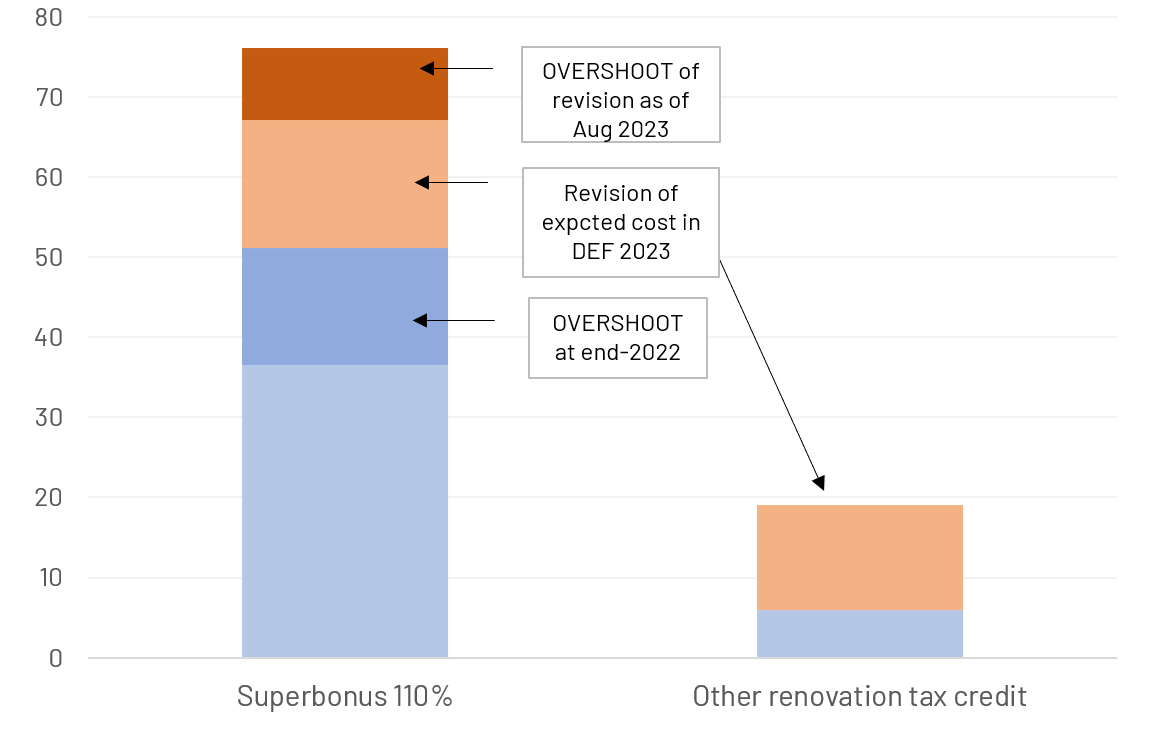On September 27th, the Italian government will publish the annual update to the 2023 budget (NADEF). This update is likely to include a revision of the headline deficit for 2023, and possibly subsequent years.
The State’s cash needs stood at EUR 81.8 bn for the first 5 months of 2023, almost EUR 46 bn higher than last year. This cash-based indicator is often used as a narrow proxy for the general government deficit. Cash-based performance can deviate significantly from accrual deficit, so cash weakness may not translate fully into revision of the headline deficit. Yet, there are risks of fiscal slippage.
Our estimate suggests the 2023 headline deficit might be revised upwards by as much as 1.5%-2% of GDP, i.e. to 6%-6.5% from the 4.5% penned in the original 2023 budget. Whether this risk will materialize, depends mostly on a pending Eurostat decision on the statistical treatment of Superbonus 110% tax credits for 2023 and on potential delays in the disbursement of the 4th tranche of Next Generation EU funds.
In addition, macroeconomic risks point to the downside and the phase out of the construction-related incentives – which acted as a strong driver for growth over the past two years – is likely to become visible in the data starting from next year. The latest EC forecast revised 2024 Italian GDP growth to 0.8% compared to the 1.5% projected by the government last year.
Following the massive increase during COVID, the debt ratio improved sizably over the past two years. This was due to the combination of an exceptionally good performance of nominal growth with high inflation. Under a more ‘normal’ scenario, however, the deleveraging path assumed in the government projections is sensitive to relatively small changes in the growth, inflation, and primary balance assumptions.
An increase in the headline deficit linked to the accounting of Superbonus tax credits would not necessarily trigger higher financing needs for 2023 – as the cash impact would materialize when (if) the credit is claimed. Claimed credits would determine lower tax revenues for the government, introducing some uncertainty in the intertemporal profile of revenues over the next few years.
Revisions to the fiscal numbers for 2023 would narrow the fiscal path going into the re-activation of EU fiscal rules (whose final shape of which is still to be agreed) and reduce the room for discretionary spending measures in 2024. At a time when the government will want to start implementing electoral pledges ahead of the EU elections, this could in turn trigger political tensions within the government majority.

Macroeconomic risks: clearly pointing to the downside.
Finance Minister Giorgetti recently reiterated his expectation that the Italian economy will hit a 1% growth target, as assumed in the 2023 budget. But risks are emerging around this projection. Flash Q2 GDP estimate pointed to a 0.3% drop, and composite PMI in August came in below 50 for the third consecutive month. ISTAT manufacturing business survey remains in negative territory and August 2023 saw a deterioration in consumer confidence. Momentum is weak, as industrial production and retail sales fell in Q2 for the fourth consecutive quarter. The good growth performance registered over the past two years has been heavily skewed by government incentives to the construction sector. As recently legislated changes to the Superbonus 110% tax credit scheme kicked in, construction output dropped by around 5% in spring and the construction PMI remains in negative territory.
Italy- Gross Value Added at constant prices (2015 = 100)

Weaker economic growth is already estimated to result into a 0.5% upward revision to the deficit, which would hence increasefrom the 4.5% penned in the 2023 budget to 5%. Growth underperformance will also complicate the debt math going forward. Debt to GDP improved sizably over the past two years due to one-off exceptional nominal growth and high inflation. The current government projections see nominal GDP growth moderating from 7% in 2022 to 3% in 2026. The same projection has stabilization of debt to GDP at around 140%, as the primary balance is expected to improve from -3.6% in 2022 to +2%in 2026 and high interest costs would be just covered by nominal growth.
The latest EU Commission forecasts, however, paint a bleaker picture. Real GDP growth is now expected to come in at 0.8% in 2024 against the 1.5% projected in the 2023 budget. A revision of the 2023 headline deficit to -6% combined with real GDP growth at 0.8% in 2024 and a moderate undershooting in 2025 growth compared to projections would suffice to keep the debt ratio at 144% of GDP – even without assuming any other fiscal slippage in future years. If the primary balance were to stabilize at around 1.5% (the average during the pre-COVID decade) rather than at 2%, the debt ratio would climb to 148% by 2030.
Budgetary impact of tax credits: still unknown.
Finance Minister Giorgetti was recently quoted in the press as stating that the Superbonus 110% “gives [him] stomachache”. The impact of these tax credits on the 2023 deficit will largely depend on Eurostat.
Until 2022, Superbonus 110% tax credits had been recognized by the State as non-payable credits. Eurostat then requested that credits related to 2020, 2021 and 2022 be reclassified as payable tax – effectively forcing the State to recognize an expense item equal to the full amount of the credits in the year in which the investment is made rather than smoothing out the impact over several years through recognition as lower revenues. This statistical reclassification led to upwards revision of the 2020, 2021, and 2022 headline deficit figures. The effect on the 2023 deficit depends on whether Eurostat will reverse the decision on the back of a recently legislated change that scrapped the transferability of the Superbonus tax credits. In that case, the government could revert to recognize the credits as non-payable.
If Eurostat will not reverse its previous decision, however, the government will need to recognize an expense for the total amount of credits attributable to 2023 in the 2023 headline deficit. In last year’s budget document (page 61 here), the government was expecting the total fiscal cost of the Superbonus tax credits to reach EUR 67 bn. Actual figures show that this expectation has been vastly exceeded: as of end-August 2023, monthly data showed that the cost had reached EUR 76 bn. Assuming the same growth continues in Q4, the final figure could climb to EUR 88 bn or more by end year.
Assuming the government had budgeted a payable tax credit expense for 2023 equal to the difference between their expectation of a total cost of EUR 67 bn and the end-2022 actual figure of EUR 51 bn, then the overshooting observed in actual tax credit numbers would suggest the need to recognize an extra EUR 21 bn (ca. 1% of GDP) as part of the 2023 government deficits, compared to projections. Additional slippage could come from negative surprises in other ongoing tax credits, the fiscal cost of which had been similarly revised upwards in the 2023 budget and that could be subject to similar underestimations. Total tax credits across all tax incentives are estimated to amount to more than EUR 120bn.
It is unclear when Eurostat’s decision – originally expected for end-June – will be published. It is important to stress that an increase in the headline deficit linked to the accounting of these tax credits would not necessarily trigger higher financing needs for 2023, as the cash impact would only materialize when (if) the credit is claimed. Claimed credits would translate into lower tax revenues for the government, introducing uncertainty in the intertemporal profile of revenues over the next 5 years.
The fiscal cost of construction tax credits (EUR bn)

EU funds disbursement: delays would be a risk.
The disbursement of the third Next Generation EU tranche – worth EUR 19 bn – was frozen by the EU Commission earlier this year but is now very likely to be disbursed before the end of the year. June 30th marked the deadline for implementation of the KPIs underpinning the fourth tranche, worth EUR 16 bn.
In early July the government advanced a request to renegotiate 10 out of the 27 targets. The effect of the 4th tranche has been included in the 2023 budget, but it now does not look inconceivable that it will be delayed 2024. The accrual impact of NGEU funds is limited to the grant component and to funds spent to finance additional investments. The grant component in the 4th tranche is EUR 8 bn. Assuming these were all destined to finance additional investment, the government would have accounted for them as lower deficit and a delay in the disbursement would imply a higher 2023 deficit by EUR 8 bn (ca. 0.4% of GDP).
The Italian request to revise the KPIs for the 4th tranche has been approved by the EU Commission on July 28th and will need approval by the EU Council on September 19th. Subject to that approval, the government could start requesting the disbursement of the funds from September 20th. The impact of delays in the disbursement of the 4th tranche on the headline 2023 deficits would most likely be counterbalanced by a positive effect on the 2024 headline deficit, but it may nonetheless impact cash-based fiscal indicators – as observed in the first part of the year.
Political Implications: cracks may appear.
An upward revision of the 2023 deficit is unlikely to trigger significant political tensions between Brussels and Rome. Other EU countries are undergoing similar macroeconomic challenges and the Italian government can credibly claim that it has inherited this situation from past governments. Moreover, the recent moves to curtail the impact of the tax credits for future years will be read as a sign of goodwill.
An upward revision of the 2023 deficit is that it complicates the fiscal path for 2024 and 2025, where the government is expected to put the balance on a decreasing path ahead of the re-activation of the EU fiscal rules (the final shape of which is still unclear). A higher deficit in 2023 will reduce the room for discretionary measures in 2024 budget, at a time the government may want to cash in on electoral promises ahead of the EU elections. This could trigger tensions within the government majority at a delicate moment, as the reform of the EU fiscal rules – where a lot is at stake for Italy – is still not agreed.
Silvia Merler, Head of ESG & Policy Research (Algebris Investments)



